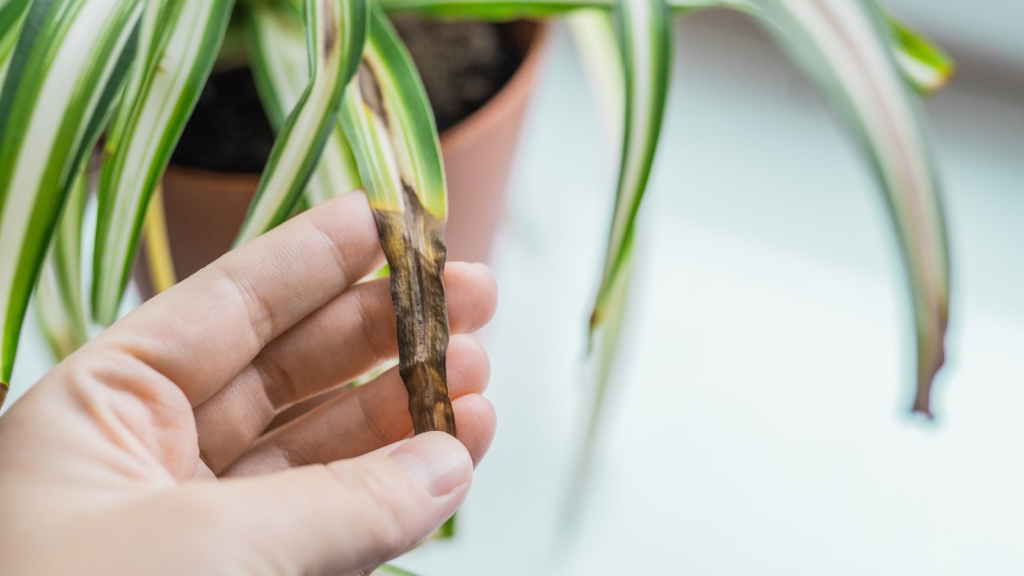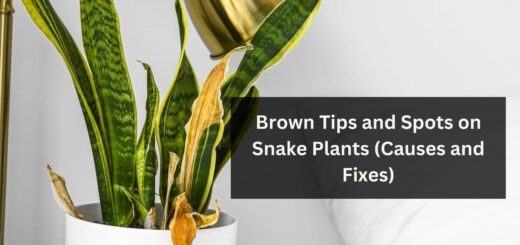How Often Do You Water Spider Plants- Full Guide
While planting different plants one day, I found my spider plant turning from green to brown and a lighter shade. I really got worried and sad because I had done hard work in planting them, but I decided not to give up and did research on the reason why the leaf’s color was fading.
At last, I succeeded in finding the reason behind this, which is not watering the spider plants correctly. Sometimes they are overwatered, and sometimes underwatered, so I follow a daily routine, which I am going to explain here to help you know how often you should water the spider plants.
Don’t worry, gardeners. If you have any further doubts regarding the watering routine, feel free to ask in the comment section below; I am always here to help you.
Spider plants:
Talking about the spider plant, also called Chlorophytum comosum, which is one of the most popular and easy-to-grow houseplants. Always maintain the watering needs to keep the plant happy. In short, you need to fulfill different amounts of water needs according to the season. If the gardener provides all the care and requirements, the spider plant is a low-maintenance houseplant that can last for years. So, are you interested in knowing some more details about spider plants? Continue reading the article.

The following are my suggestions to water the plant, for keeping the plant healthy.
When To Water Spider Plants:
- The perfect watering routine to water the spider plant is once a week which is perfect for the plant.
- Don’t water them without checking the spider plant, if the plant is thirsty or drowning to keep it healthy.
How to check if Spider Plants is under or over-watered:
The plant is used to give signs if they are overwater or underwater or they are not happy.
Step:1 The first thing you will get is turning strongly striped leaves to paler indicating that the plant is unhappy. In case to be sure whether it means they need water or not, check the soil moisture level and only then water the plant again.

Step:2 A finger test is the simplest way to check whether the plant needs more water or not, says Tim Graham, Chief Horticulturist at Yard and Garden Guru. You need to put the finger an inch or two into the soil to see if it is hard to touch or not and if the soil is hard means the plant needs more water.

Step:3 The spider plants are native to Southern Africa where the growing conditions are quite dry although the plants have evolved themselves to handle drought conditions so I can say that it is safe for you to be underwater side not to over-water the plant.
Step:4 In case, the soil gets dry the plant’s leaves will start to look pale, which indicates the plant needs water. Make sure to allow the excess water to drain out from the bottom of the pot because only a few plants are used to enjoy the water sitting on roots.

How often does a spider plant need water:
- It is important and worth it to check the spider plant soil before watering which will decide whether the plant needs water or not.
- The spider plants are the plants that require more water during the warmer season because the sunlight is used to dry out the soil and it is also the time when the plant is more active.
- “In this season you can expect the plant need get watered twice a week,” Says Christine Tobar, Owner and Founder of Botanicoeur.
- In the case of the colder months, the water needed is once a week.
- The frequency of watering the spider plant depends on the amount of Sunlight the plant is receiving.
How much to water a spider plant
If you are watering the plant regularly it will help the plant but how much water is needed by the spider plant should be also worried. According to Zahid Adnan, Founder of the Plant Bible “when you water the spider plant it is important to thoroughly moisten the soil until the water drains out of the drainage hole”. You need to ensure that the excess of water is drained away because it can lead to waterlogging and then to root rot. To avoid these circumstances use an empty saucer or cache pot which will help to prevent the condition of standing water at the bottom.
You need to observe if the spider plant is responding to watering because if there are Wilting leaves or a drooping appearance it means the plant is suffering from underwater and if the leaves turn yellow or mushy it means the plant is overwater. You need to water the plant according to the plant’s need
Factors to Consider for Watering Spider Plants:
The spider plants come under the easy-to-grow and care plants category but this doesn’t mean not to provide water to the plant. To keep your plant healthy you need to water in perfect amounts.
Here are some factors that impact how much water is required to water the spider plant which depends on the size of the pot you are using, the type of soil, the temperature, and the humidity. Let’s learn about them in detail:
Season:
- They are the plants that used to grow and Bloom faster during the warmer months.
- You need to adjust the water schedule according to the season which will help the plant to remain healthy.
- The spider plant is used to thrive in the warmer seasons having more fresh leaves new plantlets and flowers.
- Want to keep the plants alive and healthy make sure to give them more water than the usual watering schedule during warmer months.
- They are used to grow slowly during the winter months.
- Avoid the condition of roots getting damaged during colder winter months due to overwatering so here you can reduce the watering frequency.

Temperature:
- The plant is used to remain happy and comfortable in temperatures between 55 degrees Fahrenheit and 65 degrees Fahrenheit.
- A high temperature over 80 degrees Fahrenheit will cause the plant to increase in respiration.
Signs of Underwatered Spider Plant:
- The Spider plants are used to observe more water resulting in soil getting dry more quickly.
- In winter months there is the opposite effect water required by the plant is less because the plant becomes inactive during this month.

Plant Size:
- If the size of the spider plant is big they will consume a higher amount of water than the smaller plant because larger plant roots are well developed which makes them observe more water because of having a larger surface area.
- The larger plants are used to increase the loss of moisture due to photosynthesis and transpiration.
- The first year of the plant growth is when they have Rapid growth where you need to water them more.
- You need to water the plant a minimum of once a week.
- If you have smaller plants water them twice in three weeks or until you see any difference in the soil moisture.
Humidity:
- The spider plants consume less water if they have higher humidity which reduces transpiration.
- In case the temperature is high and humid the need for the water to the plant is less frequent.
- The plant growing in low humidity will have an effect on their leaves because it will speed up the water loss which results in the soil becoming drier at a faster rate.
- To maintain the spider plant always water the plant more often than in regular ways.
- To ensure how much water is required by the spider plants use a soil moisture meter
Location:
- In case of keeping the spider plant near a south-facing window then water the plant more frequently because here they receive more sunlight in that direction.
- In case the plant is placed near the heat vents, lamps radiator, or any other heating sources the plant will need more water.
- The need for water by the plant is less if they do not receive too much sunlight.
Plastic Pots:
- The type of the pot also affects the amount of water the plant needs.
- If you are using a plastic pot then water the plant less because the pot is not as breakable as other materials that are used to hold the moisture for a longer time.
- Also before watering the plant in the plastic pot make sure to check the soil before watering

Self-Watering Planter for Spider Plant:
It is a perfect way to keep the spider plant healthy and thriving. You can look for a pot that will help the plant grow healthy and remain hydrated then I suggest you get a self-watering planter which is designed in a way that slowly releases water to the plant which makes you not to worry about watering the plant.
Planterhoma do consists of a variety and wide self-watering planter which is perfect for any type of plant. They come in a variety of sizes and styles so you can get the perfect one according to your need. They are made up of high-quality material so you don’t have to worry about the plant. You can get the self-watering planter from Planterhoma.
Size of Pot:
- The plants that are growing in smaller pots need to be watered more often when compared to the spider plants growing in larger pots because the small pots dry out more quickly than the larger pots.
- Which type of pot is used to grow the spider plant also impacts how often you need to water the spider plant.
- In case of using a larger pot, the soil will become wet and water-logged.
Overwatered Spider Plant:
- Over-watering the spider plant will cause root rot.
- I suggest you select a medium-sized pot, let the soil dry out then only water the plant.
- The amount of water for watering the plant depends upon the size of the pot and amount of the soil you are using and how often the soil gets dry.

Potting Mix:
- To find out how often you need to water the spider plant depends upon the type of potting mix you are using.
- Different type of potting mix is used to hold different amounts of water for different periods all of this impact on how much water is required for your plant. So make sure to water the spider plant according to the potting mix that you use.
- It will help to determine the watering schedule that will be good for your plant.
- There are many types of soil available on the market but not all are created with equal value.
- Talking about the spider plant the best type of soil to use for them is the leca balls.
- The leca Balls are lightweight and Aries soil helps to aerate the soil and prevent compaction which will result in improved drainage
Symptoms of Overwatering and Underwatering
Overwatering:
- If the plant starts to show brown or sandy color areas which are common symptoms of overwatering that happens in the winter.
- To make a healthy plant with spiky arched green leaves having vivid white stripes, you need to first stop watering the plant regularly in case of observed streaking, browning at the tips, or mottling on the leaves.
- After that check if the plant has improved a few days later.
- The plant will start to lose the vibrant vigor or will start to wilt or flip in the pot which is the other symptom that the plant is overwatered.
- To prevent it, use a drip tray or sauces that will catch the extra water after watering the plant which will prevent water from getting collected in the pot.
- It will save the plant root from growing in soggy wet soil but here you need to empty the tray after every 30 minutes you water the plant.
Underwatering:
- Underwater is another issue for the spider plant because you need to make sure the plant does not leave without watering as soon as the soil dries.
- If the plant is underwater, the leaves of the plant will begin to turn to lighter shade.
- The leaf of the plant will lighten the color for a normal deep color.
- Underwater will also make the plant leaves curl up with the length growing which means you need to water the plant again.
- In case if you have water, then wait for a few couples of days to let the soil dry up before checking if the plant leaves have started to unfurl or not and waiting for extra days, will be preferable to avoid over-watering of the plant.
- All these symbols will help you to know whether the plant needs water or not.
Tips for Watering Spider Plant:
The following are symptoms that you can follow for water in the spider plants:
- Growing healthy spider plants depends upon the soil. If the soil is too salty the plant will not be happy so whenever you water the plant you need to make sure the soil is wet and full of Nutrients and remember to inspect the soil before watering them.
- You need to repot the Spider plant every 2 years. Using fresh soil for the plant will be beneficial which will help in avoiding various issues such as dark leaves on inadequate feeding, salt buildup in the pot, or excessive fluoride present in water.
- In case the plant begins to pull out from the soil then fresh soil every couple of years so that the plant blossoms beautifully. You can think in a way that giving the plant fresh soil is a new makeup every couple of years that will help them to encourage their growth.
- The plant can also be hydrated using rainfall or filtered water because the chlorine and chloride present in the water do cause the tip of the plant leaves to turn brown.
- If you water the spider plant with tap water, it will not do much harm but it is always recommended to use rainwater or filter water to keep the plant healthy.
- You need to regularly mist spider plants because they are native to locations having moderate humidity.
- Misting the spider plant at least once a week using water will simulate the humidity according to its natural habitat.
- If you live in a dry environment, spray the plant more often because the low humidity will turn the tip of the plant to brown which is the sign that the plant is under stress.
- If you keep the plant in a location where direct air current or close the source of the plant will dry out too soon.
- Make sure to keep the plant in a place where there is no heat register or air-conditioning unit which will help them prevent dry conditions.
- The plant is all able to tolerate a variety of temperatures, but they thrive in temperatures between 65 to 75°F during the day and 55°F at night.
- In case the temperature rises over 80°F inside the house, it will cause the spider plant leaves to turn brown. Here you need to water the plant more frequently to make its leaves happier.
- You need to provide the plant with a perfect pot that is a little bit bigger than the root ball which can promote the plant to produce spiderettes for reproduction and will allow the soil to dry out.
- Although the plants do require regular watering, they are not picky about how they are watered.
- You can provide them with a basic watering schedule and really need to look for signs of overwatering or underwatering the plant.
Conclusion:
After reading the article you will have an idea of how often you need to water spider plants when to do so, and How to treat them when it’s being overwatered or underwater. To save your plants you need to follow the tips for watering spider plants that I have explained in this article.


